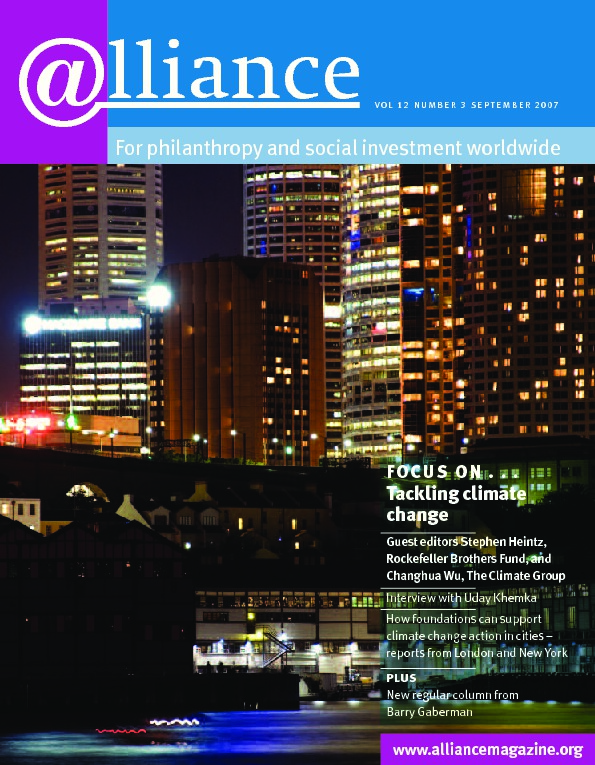When the history of the US response to climate change is written, a large chapter will have to be devoted to the crucial role played by the philanthropic community to support advance solutions. One way private funders can achieve huge leverage is by investing in non-profit think-tanks and policy centres like the Center for Climate Strategies (CCS), which helps US states develop and implement comprehensive climate action plans.
Since 2000, and thanks to funding from the donor community and the high level of technical and facilitative capacity that it provided, we have been able to support 20 state governors in addressing complex and potentially controversial issues related to climate change policy. Today, it is the states that have the most to show on climate action, with governors providing a core of experienced leadership on climate change in the US.
A climate change in the opinions of policymakers
Moreover, the ramifications of state action have been much larger than could have been expected from the original investment in a few state climate action plans. The development of gold standard approaches to climate policymaking has helped create awareness in the US congress and administration both of solutions ready for implementation and of the need for US leadership. Actions by states are paving the way for the US to move from laggard to leader.
State climate solutions have galvanized the formulation of a national policy capable of reaching steep emissions reductions while protecting and enhancing the US economy. US legislation, especially in the environmental arena, has historically been based on models developed in state ‘laboratories of innovation’, the results of which prompt action at national level. The work of states has been instrumental in producing a mood across the nation in favour of a range of climate policy actions.
The landmark ruling of the Supreme Court in April (see below) makes a national commitment inevitable, and the traditional role of state action under the Clean Air Act opens the door for incorporation of national standards, innovative new programmes and state implementation plans that could provide a full solution to the nation’s emissions problem.
The work of CCS
The team that we have assembled at CCS has been involved in most state climate policy development processes begun since 2000. Currently, we are actively working with 12 governors on new state climate action plans, and leading the facilitation of two important efforts in the Western region. Another dozen or so states are gearing up to start a planning process with our assistance, and several plans have been completed in the past few years. What exactly does CCS do?
We use a fact-based, consensus-building process that identifies a full range of priorities and potential solutions for analysis, and ultimately a portfolio of climate mitigation options picked by state stakeholders, tailored to individual states. To begin the process, we convene state officials and representatives from key stakeholder groups and build consensus around an inventory and forecast of emissions and potential solutions using proven techniques of dispute resolution, corporate planning, and collaborative decision-making. Through regular meetings and discussions, supported by technical analysis, we then facilitate consensus-based development of potential policy solutions. Finally, we provide a detailed report with recommendations to state cabinet officials and the governor (and in some cases, the legislative leader), who then work to implement actions.
Planning processes are usually convened by the governor, but may also be convened by law or private initiative. The governor invites a high-level group of stakeholders to participate along with technical work group representatives, assigns agency staff to the planning process, and directs cabinet officials to support and participate in the effort. Typically, a group of 25-35 stakeholders participate, including representatives of industry, agriculture, environmental and conservation organizations, public interest groups, academia, state and local government, and Native American tribes.
Building consensus
Central to our work is expert consensus-building. One of the primary skills of CCS is the ability to help states work through the potential conflicts that arise when climate and energy issues are discussed. Our collaborative model allows states to discuss serious climate action safely, free from the political pressure and potentially adverse publicity that might doom the effort.
Without this kind of process, states can rarely build a strong enough consensus for a full range of climate actions, or resolve difficult conflicts embedded in traditional political culture. The climate programmes and policies that emerge from our work create economic as well as environmental benefits. They are politically desirable and often quickly implemented. Even more important are the collaborative relationships that are formed by diverse and sometimes unlikely partners.
It is important to underscore that a climate action plan is not a single policy measure. It is a portfolio of measures whose effectiveness derives from the simultaneous and mutually reinforcing effect of each of its provisions. The plan addresses economic opportunities for action related to cars, houses, open spaces, appliance standards, energy generation and more. Solutions for climate change become ubiquitous across significant emissions sources and sectors. The cost and the burden of action can be spread across all sectors, creating politically palatable solutions that stakeholders can agree to uphold together.
We can do this because we act as a neutral catalyst of a self-determined process. We are not advocates for particular approaches or vested interests, and we do not take positions on policy or legislative issues. Rather, our work is collaborative, technical and facilitative. We ask our state partners to provide as much financial support as possible to these planning processes, but typically they can fund only a small proportion. We can often make a significant contribution by working with a variety of private donors who provide the support needed.
While US climate action is growing at an increasing rate, much work remains to translate state and regional action into federal solutions and international cooperation. Our state-level work has led to requests for regional assistance, and recently we initiated facilitation of the Western Climate Initiative. This is an important collaborative of US and Mexican states and Canadian provinces exploring the formation of a regional cap-and-trade system and other policies. It will provide guidance from a regional level for a comprehensive national programme. CCS is also undertaking evaluation of combined federal and state level solutions emanating from state work, as well as from an important Supreme Court decision handed down in April this year.
The economic argument
Many of the state action plans we facilitate project significant reductions in greenhouse gas emissions while at the same time delivering net economic savings to the state economy – often in the billions of dollars. We have conducted a preliminary assessment of the impact of state action if scaled up to a national level. We found that a portfolio of measures enacted nationally could reduce emissions in the US to 1990 levels by 2020 while returning as much as $100 billion to the national economy.
Many of these measures could be implemented immediately and put the nation on a climate stabilization trajectory while other mechanisms – such as a cap-and-trade system, which require years to negotiate and deploy – are put in place. By moving forward immediately with a full set of solutions, the US can also stimulate other nations to action.
Important new options to manage greenhouse gases under the Clean Air Act emerged with the Supreme Court’s April ruling in Massachusetts vs EPA, where the court ruled that the Clean Air Act (CAA) gives the Environmental Protection Agency (EPA) authority to manage carbon emissions and other greenhouse gases. Further, the court ruled that the agency cannot sidestep its authority to manage greenhouse gases that contribute to global climate change unless it can provide a scientific basis for its refusal. On this basis, we believe a national programme to address climate change under the CAA is now inevitable. Although the EPA is unlikely to act upon this opportunity under the current administration, the possibility that a future president could exercise authority to manage emissions without Congressional legislation changes the dynamics of climate policy development significantly.
CCS is examining how the CAA could be applied to harness the full range of climate mitigation actions undertaken by states in combination with future federal action, including scale-up analysis of state leadership actions, and mapping of policy mechanisms needed to support actions in all economic sectors and levels of government.
It’s worth restating here the role that donors can play in this work. States can seldom allocate the funds to cover what needs to be done and we continue to rely on the funding community to support our efforts. In view of the influence of state-level action on national policy and beyond, the return on such investment is potentially enormous. If it ultimately helps to produce effective global action to combat climate change, its value will be incalculable.
Tom Peterson is Executive Director of the Center for Climate Strategies. Email tdp1@mac.com
For more information
http://www.climatestrategies.us






Comments (0)